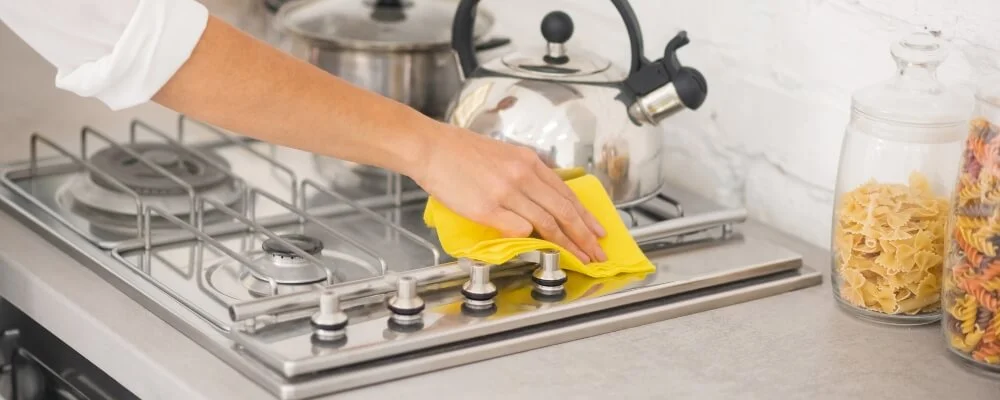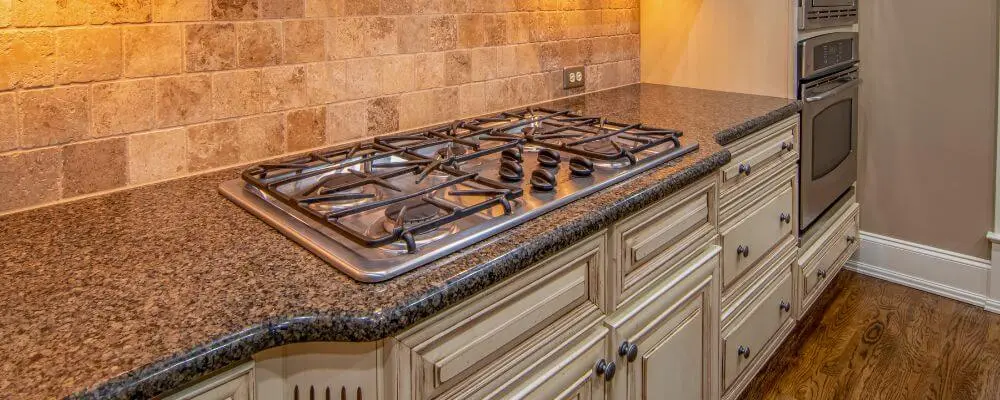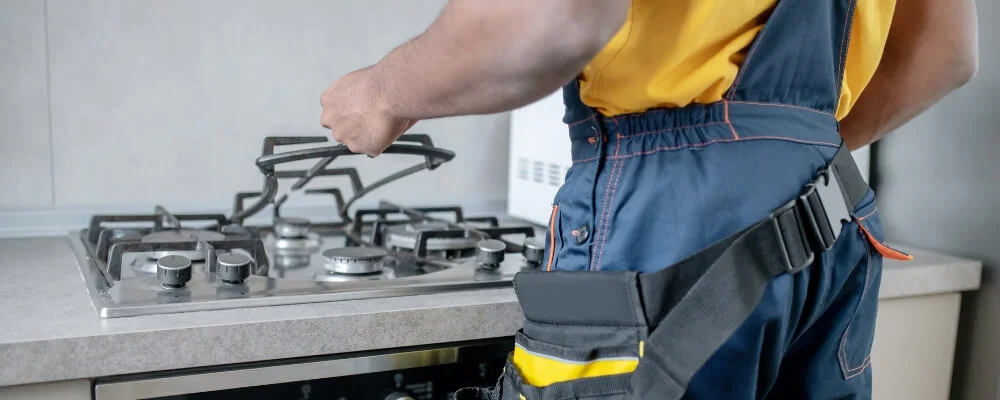In the heart of our kitchens lies a tool integral to the culinary adventures we embark upon daily—the gas stove. Revered for its quick heating capabilities and precise temperature controls, the gas stove is a favourite among many home cooks and professional chefs. However, with its widespread use comes the responsibility of understanding its potential hazards. While getting accustomed to its daily operation might be easy, forgetting its intrinsic dangers could have dire consequences.
This blog aims to spotlight the vital safety measures every user needs to adopt. From installation nuances to the minutiae of daily operations, we’ll walk you through 10 essential tips to ensure your cooking endeavours are delicious and safe. Join us as we dive deep into gas stove safety, ensuring this beloved kitchen appliance serves us without posing risks.
Hazards Associated With Gas Stoves
Gas stoves are popular in many households due to quick heating and precise temperature control. However, they come with potential hazards if not used or maintained correctly. Here are some of the primary hazards associated with gas stoves:
- Gas Leaks: The potential for gas leaks is the most significant hazard with gas stoves. Leaking natural gas or propane can accumulate and pose a risk of explosion. Additionally, natural gas leaks can lead to inhaling harmful chemicals, harming health.
- Carbon Monoxide Poisoning: Incomplete combustion in gas stoves can produce carbon monoxide (CO), an odourless and colourless gas. Inhalation of CO can interfere with the blood’s ability to transport oxygen, leading to symptoms like headache, dizziness, weakness, upset stomach, vomiting, chest pain, and confusion. Prolonged exposure can be fatal.
- Fire Hazards: Gas stoves have an open flame, which increases the risk of fires, especially when flammable items are left near the stove or when grease accumulates. Also, if a burner doesn’t ignite immediately after turning it on, gas will continue to release. When it finally ignites, it can produce a larger flame than expected, leading to burns or fires.
- Burns: Direct contact with the flame or hot surfaces, including pots and pans, can cause burns. Especially concerning situations where children or pets are unsupervised near a working stove.
- Explosions: Explosions can occur when gas accumulates without being noticed and ignites by a spark or flame. This is more extreme but can result from significant gas leaks.
- Chemical Exposure: Some older models of gas stoves might release harmful chemicals, including formaldehyde, nitrogen dioxide, and other volatile organic compounds (VOCs). Inhaling these chemicals over time can have adverse health effects.
- Tip-over Hazards: If not correctly installed or anchored, gas stoves can tip over, especially when heavy pots or pans are placed on open oven doors. This can lead to injuries and fires.
- Foodborne Illness: This is an indirect hazard. If the gas stove isn’t functioning correctly, it might not heat food to the required temperature, leading to potential foodborne illnesses due to undercooking.
- Environmental Impact: Gas stoves release greenhouse gases and other atmospheric pollutants. While each stove might release a small amount, collectively, this can contribute to environmental concerns.
- Operational Errors: Misuse or unfamiliarity with the stove’s operations can lead to various risks, including leaving the gas on without ignition, leading to gas buildup.
Understanding these hazards is essential for ensuring gas stoves’ safe operation and maintenance. Regular inspection and maintenance, proper usage, and awareness of the associated risks are crucial for safely enjoying the benefits of a gas stove.

10 Gas Stove Safety Tips You Need To Know When Using It.
Like most people, you use your gas stove daily to cook meals for your family. It’s a convenient way to prepare food, and it’s fast. However, the following are 10 safety tips you need to know before using a gas stove.
1. Installation and Maintenance
The initial setup of your gas stove sets the tone for its safety and efficiency. A certified professional has the expertise to correctly install your stove, ensuring all connections are secure and the stove operates optimally. Once installed, the stove isn’t a set-it-and-forget-it appliance. Over time, gas lines can degrade, or connections might loosen, leading to gas leaks. Hence, routine self-inspection is crucial.
Look for any signs of wear on the gas lines or any disconnections. However, a layman’s eye might miss what a professional can spot, which is why periodic inspections by a professional are invaluable. They can carry out comprehensive checks and necessary maintenance to ensure the stove’s longevity and safety.
2. Ventilation
Cooking on a gas stove releases combustion by-products into the air. If these aren’t properly vented out, it can lead to indoor air pollution and increase the risk of carbon
monoxide exposure. Carbon monoxide is colourless, odourless, and lethal in large amounts. Ensuring proper ventilation using a range hood or vent fan helps in removing these gases, making your kitchen environment safer. Not only does this help vent harmful gases, but it also keeps your kitchen cooler and reduces odours.
3. Avoid Loose Clothing
A kitchen is a place of action. Pots are boiling, pans are sizzling, and if you’re wearing loose clothing, you might inadvertently let a sleeve or a part of your attire dangle too close to the flame. This can lead to accidents, as cloth can catch fire rapidly. Always be conscious of what you wear in the kitchen. Opt for snug-fitting sleeves and avoid flowy garments. It’s a simple measure that can prevent a potentially dangerous mishap.
4. Check the Flame
The colour of your stove’s flame directly indicates its combustion efficiency. A blue flame signifies complete combustion, which means the gas is used effectively and safely. However, a yellow or orange flame indicates incomplete combustion. This is a concern because the gas isn’t burning efficiently, releasing higher amounts of carbon monoxide. Calling in a professional is essential if you observe a consistent colour change away from blue. They can assess and rectify the issue, ensuring the gas burns cleanly and your safety isn’t compromised.

5. Never Use as a Heater
During colder months, turning on the gas stove for a burst of warmth might be tempting. However, this is a perilous misuse of the appliance. Using the stove as a heater can cause a rapid buildup of carbon monoxide in the room, especially if it’s not properly ventilated. Carbon monoxide poisoning can lead to symptoms like dizziness and headaches, which can be fatal in severe cases. Always use appliances for their intended purpose. Invest in a proper heating system or use portable heaters designed for indoor spaces if warmth is needed.
6. Child and Pet Safety
The kitchen can be captivating for children and pets, with its sights, smells, and sounds. But it’s also a place where accidents can happen in a split second. Due to their natural curiosity, children might reach out to touch a pot or pan, risking burns or spills. Pets, especially cats that might jump onto counters, are also at risk.
To prevent accidents, always supervise any young child or pet when they’re in the kitchen. Prioritize using the stove’s back burners, as it makes it more difficult for kids or pets to accidentally come into contact with hot cookware. Additionally, turning pan handles inwards ensures they can’t be easily knocked over or pulled down.
7. Clear the Surrounding Area
A cluttered stove area isn’t just messy—it’s a fire hazard. Flammable items, such as paper towels, dishcloths, or certain food items, can catch fire if they come close to the stove’s open flame. Similarly, food residues or grease buildup can ignite and cause a kitchen fire. Regularly cleaning your stove and keeping its surrounding area clear minimizes these risks. It’s a good habit to wipe down the stove after each use and to always ensure combustible materials are stored away from the stove.
8. Know How to Put Out a Fire
Fires can be terrifying, but knowing what to do can prevent a small mishap from becoming a catastrophe. Grease fires are especially treacherous since adding water can cause the fire to flare up and spread. In such cases, turning off the gas is your first defence—cutting off the fuel source. A metal lid can smother a pan fire by depriving it of oxygen.
While baking soda can effectively extinguish small grease fires, flour should be avoided as it can exacerbate the flames. Every kitchen should have a fire extinguisher designed specifically for kitchen fires, and more importantly, every household member should know its location and operation.

9. Check for Gas Leaks
Natural gas has a distinct odour—often likened to rotten eggs or sulfur—to make it detectable since it’s naturally odourless. This smell is your first clue that there might be a gas leak. If you detect this scent, especially when the stove isn’t in use, it’s crucial to act swiftly. Avoid turning on electrical appliances or lights, which could ignite the gas. Open windows to allow ventilation, which helps disperse the gas. For safety, evacuate your home and call your gas company or a professional to address the issue.
10. Know How to Shut Off the Gas
Every household member should be familiar with the location and operation of the main gas shut-off valve. In emergencies, such as significant gas leaks or fires, shutting off the main gas supply can prevent further escalation. Regularly review the shut-off procedure with family members and ensure easy access to the shut-off valve, free from obstructions.
Conclusion
Navigating the culinary landscape with a gas stove is both an art and a responsibility. While the allure of whipping up delectable dishes is undeniable, it’s paramount that our safety and those around us remain at the forefront of our cooking escapades. Through the 10 safety tips we’ve discussed, we’re reminded that knowledge and precautionary measures go hand in hand in ensuring that every cooking session is a gastronomic delight and a safe experience.
As with all tools, a gas stove is best used correctly. So, the next time you fire up those burners, remember the essence of these guidelines and let them guide your actions. Here’s to delicious and more importantly, safe culinary journeys!





